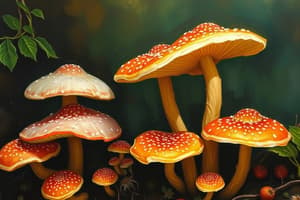Podcast
Questions and Answers
Which phylum of fungi is mainly aquatic and microscopic, with organisms that reproduce asexually and move around using flagella?
Which phylum of fungi is mainly aquatic and microscopic, with organisms that reproduce asexually and move around using flagella?
- Ascomycota
- Chytridiomycota (correct)
- Basidiomycota
- Glomeromycota
What type of reproduction is common in Zygomycetes, the fungi from Zygomycota?
What type of reproduction is common in Zygomycetes, the fungi from Zygomycota?
- Reproduction through dikaryotic stage
- Sexual reproduction through fusion of hyphae
- Asexual reproduction through spores (correct)
- Reproduction by fragmentation
Which phylum of fungi is known for their symbiotic relationship with plants, forming arbuscular mycorrhizae?
Which phylum of fungi is known for their symbiotic relationship with plants, forming arbuscular mycorrhizae?
- Glomeromycota (correct)
- Zygomycota
- Ascomycota
- Chytridiomycota
What is the main way through which most fungi reproduce?
What is the main way through which most fungi reproduce?
Which phylum of fungi includes examples like Rhizopus stolonifer, a bread mold that grows on decaying plant material?
Which phylum of fungi includes examples like Rhizopus stolonifer, a bread mold that grows on decaying plant material?
In which stage do multicellular fungi have two sets of chromosomes that remain separate?
In which stage do multicellular fungi have two sets of chromosomes that remain separate?
Which phylum of fungi is known for forming mycorrhizal associations with plants?
Which phylum of fungi is known for forming mycorrhizal associations with plants?
Which phylum of fungi includes species that can cause athlete's foot and ringworm infections?
Which phylum of fungi includes species that can cause athlete's foot and ringworm infections?
Which phylum of fungi includes mushrooms as a common example?
Which phylum of fungi includes mushrooms as a common example?
Which fungal phylum is NOT mentioned in the given text?
Which fungal phylum is NOT mentioned in the given text?
Which fungal infection is caused by dermatophytes and can affect the skin on the feet, hands, and nails?
Which fungal infection is caused by dermatophytes and can affect the skin on the feet, hands, and nails?
Which fungal species is mentioned as normally found inside humans in the respiratory, gastrointestinal, and female reproductive tracts?
Which fungal species is mentioned as normally found inside humans in the respiratory, gastrointestinal, and female reproductive tracts?
How do yeasts such as Saccharomyces reproduce?
How do yeasts such as Saccharomyces reproduce?
What distinguishes macroscopic filamentous fungi from moulds?
What distinguishes macroscopic filamentous fungi from moulds?
How do hyphae of filamentous fungi grow and form a network?
How do hyphae of filamentous fungi grow and form a network?
What is the main function of digestive enzymes secreted from the hyphal tip of fungi?
What is the main function of digestive enzymes secreted from the hyphal tip of fungi?
Which type of fungi are known for playing an important role in bread production and brewing?
Which type of fungi are known for playing an important role in bread production and brewing?
What is the size of yeasts compared to red blood cells?
What is the size of yeasts compared to red blood cells?
Flashcards are hidden until you start studying




